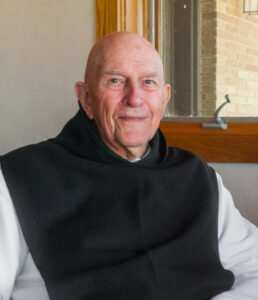Although Centering Prayer was developed as a response to Vatican II in the 1970s through the work of three Trappist monks, Fathers William Meninger, Basil Pennington and Thomas Keating, this practice draws its wisdom from ancient Christian roots.
Inspired by the fourteenth century classic The Cloud of Unknowing and the writings of mystics such as John Cassian, Francis de Sales, Teresa of Avila, John of the Cross, Therese of Lisieux, and Thomas Merton, Centering Prayer is guided by the wisdom of Jesus’ words inviting us to pray in secret (Matthew 6:6).
The practice of Centering Prayer is simplicity itself.
Choose a sacred word. Examples might be Peace, Jesus, Light, Love, Joy, Abba or whatever word resonates with you. The sacred word is not sacred because it sounds sacred or holy. The word represents or signifies your intention to yield or consent to God’s presence and activity in the deepest center in your being. This intention to consent is the sacred thing in this prayer. Although most people choose a spiritually derived word, yours could be one that doesn’t sound sacred at all. It just needs to signify your intention to consent. This word should remain the same for all your prayer periods.
Set a timer for 5-20 minutes. Although the recommended time is two 20-minute sessions per day, the length and frequency is up to you.
Find a quiet place and position yourself comfortably.
You need not say your sacred word. Just bring it to your awareness as an expression or symbol of your intention to consent to God’s presence and activity in the deepest center of your being.
Then let your sacred word go.
Now it’s just you and your thoughts. Let them come and go—even wonderful thoughts or feelings of peace, joy or bliss. Don’t try to block them or empty your mind.
At some point, we all get hooked, engaged or stuck on a thought. We start writing that grocery list, try to solve a problem or recall a wonderful or painful memory. When this happens, bring your sacred word back to your awareness as a means of re-expressing your intention to consent to God’s presence and activity in the deepest center of your being. Then let the sacred word go. Engaged again? Use your sacred word.
With this gentle permission to let your thoughts come and go, you are being present to the God who is closer to you than your thoughts…deeper within you than your thoughts. That’s why in this prayer you let your thoughts simply come and go—even the spiritual thoughts.
But don’t try to focus on God even though this prayer can feel nondescript or even a little boring. As humans, we want it to feel bigger, so much more spiritual and this is where your faith comes in.
The faith we bring to this prayer is the faith that, beneath our thoughts, beneath our awareness, God is at work in the deepest center of our being and responding to our consent. God sees us, knows us and recognizes our needs better than we do. So in this prayer we are essentially placing ourselves in God’s hands and trusting that God is perfectly at work deep within for our transformation and healing and growth.
Therefore the real fruits of this prayer are not experienced in the prayer period itself but over time as we do the prayer regularly. What are those fruits?
How do I learn the method of Centering Prayer?
It will support your practice along with giving you encouragement and friendship in faith along the way. See the list of local Centering Prayer groups >
Read Open Mind, Open Heart by Thomas Keating. Originally published in 1986, this book is the definitive classic for deepening your understanding.
ContemplativeOutreach.org has an extensive library of articles and inspiration by various authors.
Download a short, instructive pamphlet published by Contemplative Outreach > Centering Prayer pamphlet
An ongoing program of Introductory Centering Prayer Workshops and retreats is offered by Contemplative Outreach of Kansas City to teach the method and support people in their practice.
Find out how to schedule this workshop at your location >


 “Centering Prayer is a method of silent prayer that prepares us to receive the gift of contemplative prayer, prayer in which we experience God’s presence within us, closer than breathing, closer than thinking, closer than consciousness itself. This method of prayer is both a relationship with God and a discipline to foster that relationship.
“Centering Prayer is a method of silent prayer that prepares us to receive the gift of contemplative prayer, prayer in which we experience God’s presence within us, closer than breathing, closer than thinking, closer than consciousness itself. This method of prayer is both a relationship with God and a discipline to foster that relationship.